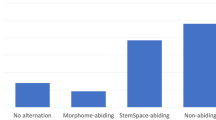Abstract
An intricate system of adjective intensification permeates Sui, a Tai-Kadai minority language of Guizhou Province, China. Sui adjective intensifiers show evidence of partial reduplication involving a complex interplay of morphophonological processes: rhyme, alliteration, The Emergence of The Unmarked (TETU), and identity avoidance patterns that support Kennard’s “Copy but don’t repeat” [(2004). Phonology, 21(3), 303–323]. This Sui phenomenon has never been reported to the wider linguistic community beyond Guizhou, and it provides valuable theoretical insight into reduplication and related morpho-phonological processes. Moreover, the interaction of these morpho-phonological processes forms a system of patterned variety that may be viewed as a poeticized lexicon or lexicalized poetry, thus illustrating the presence of extensive poetic effects embedded within the core grammar. In this way, Sui provides strong support for Yip’s observation that “humans have both an aptitude and a taste for creating repetitive sequences, and they may use this skill in a variety of ways that are more or less part of the core grammar of the language” [(1999). Glot International, 4.8, 1–7].
Similar content being viewed by others
References
Alderete J., Beckman J., Benua L., Gnanadesikan A., McCarthy J., Urbanczyk S. (1999). Reduplication with fixed segmentism. Linguistic Inquiry 30, 327–364
Bloomfield L. (1933). Language. New York, Henry Holt and Company
Burusphat, S., Wei, X., & Edmondson, J. A. (2003). Sui (Shui) Chinese-Thai dictionary. Bangkok: Mahidol University (Sui, Chinese, and English entries by Wei and Edmondson).
Chao Y.R. (1930). A system of tone letters. La Maitre phonetique 45, 24–27
Duanmu S. (2000). The phonology of standard Chinese. Oxford, Oxford University Press
Edmondson, J. A., & Solnit, D. B. (Eds.). (1988). Comparative Kadai: Linguistic studies beyond Tai. Dallas, TX: SIL.
Edmondson J.A., Esling J.H., Harris J.G., Wei J. (2004). A phonetic study of the Sui consonants and tones. Mon-Khmer Studies 34, 47–66
Ito J., Mester A. (1999). The phonological lexicon. In: Tsujimura N.(ed) The handbook of Japanese linguistics. Oxford, Blackwell, pp. 62–100
Jakobson R. (1960). Closing statement: Linguistics and poetics. In: Sebook T.A.(ed) Style in language. Cambridge, MA: MIT Press, pp. 350–377
Jakobson R., Waugh L. (1979). The sound shape of language. Bloomington and London, Indiana University Press
Kager, R. (1999). Optimality theory. Cambridge University Press.
Kennard C.H. (2004). Copy but don’t repeat: The conflict of dissimilation and reduplication in the Tawala durative. Phonology 21(3): 303–323
Kenstowicz M. (1985). Multiple linking in Javanese. NELS 16, 230–248
Leben, W. (1973). Suprasegmental phonology. PhD dissertation, MIT
Li F.-K. (1948) The distribution of initials and tones in the Sui language. Language 24(2): 160–167
Luo, S. (1992). Sandu Shuizu Zizhixian Zhi [Sandu Sui Autonomous County Report].Guizhou, China: Guizhou People’s Publishing.
McCarthy J. (1986). OCP effects: Gemination and antigemination. Linguistic Inquiry 17, 207–263
McCarthy, J., & Prince, A. (1993). Prosodic morphology I: Constraint interaction and satisfaction. ms., University of Massachusetts, Amherst, and Rutgers University.
McCarthy, J., & Prince, A. (1994). The emergence of the unmarked: Optimality in prosodic morphology. NELS, 24, Proceedings of the 24th Conference of the Northeast Linguistics Society, University of Massachusetts, Amherst, pp. 333–379.
Prince, A., & Smolensky, P. (1993). Optimality theory: Constraint Interaction in Generative Grammar, ms., Rutgers University and University of Colorado, Boulder. Published 2004, Blackwell: Malden, MA, and Oxford.
Shuiyu Diaocha Baogao (1956) Report on Investigations of the Sui Language. Ms.
Stanford J.N. (2004). Shuiyuzhong xingrongcide tedinghouzhui diaocha, [A study of Sui wordspecific adjective suffixes]. Qiannan Minzu 33, 34–39
Stanford, J. N. (To appear). Lexicon and description of Sui adjective intensifiers. Linguistic Discovery, 4(2).
Suzuki, K. (1998). A typological investigation of dissimilation. Ph.D. dissertation, University of Arizona.
Thompson L.C. (1965). A Vietnamese grammar. Seattle, University of Washington Press
Wei, X. (1999). Shuiyu Xingrongci Houzhui Yanjiu [Research of Sui language adjective suffixes]. In Shuijiaxue Yanjiu (Vol. 3, pp. 221–225). Guizhou, China: Guizhou Province Sui Association.
Yip, M. (1995a). Identity avoidance in phonology and morphology. ms, University of California, Irvine.
Yip, M. (1995b) Repetition and its avoidance: The case of Javanese. In K. Suzuki & D. Elzinga (Eds.), Proceedings of South Western Optimality Theory Workshop 1995 Arizona Phonology Conference vol. 5: University of Arizona Department of Linguistics Coyote Papers, pp. 238–262.
Yip M. (1996). Lexicon optimization in languages without alternations. In: Durand J., Laks B.(eds) Current trends in phonology: Models and methods Vol. 2. Salford, University of Salford Publications, pp. 757-788
Yip M. (1998). Identity avoidance in phonology and morphology. In: LaPointe S., Brentari D., Farrell P.(eds) Morphology and its relation to phonology and syntax). Stanford, CA: CSLI Publications, pp. 216-246
Yip M. (1999). Reduplication as alliteration and rhyme. Glot International 4.8, 1–7
Yip, M. (2001). Segmental unmarkedness versus input preservation in reduplication. In L. Lombardi (Ed.), Segmental phonology in optimality theory (pp. 206–230). Cambridge University Press.
Yu J., Snyder W., Snyder D. (1994). Two initial grammatical discoveries in the Fucun speech of Libo Buyi. In: Milliken S.R.(ed) SIL occasional papers on the minority languages of China vol. 1. Hong Kong, Summer Institute of Linguistics, pp. 1–11
Zeng X., Yao F. (1996). Hanshui Cidian [Chinese-Sui Dictionary]. Chengdu, China, Sichuan People’s Publishing
Zhang J. (1980). Shuiyu Jianzhi [Sketch of the Sui language]. Beijing, Minorities Publishing House
Zhang J., Lai Y., Turnbill-Sailor C. (2006). Wug-testing the ‘tone circle’ in Taiwanese. Proceedings of WCCFL 25.
Author information
Authors and Affiliations
Corresponding author
Rights and permissions
About this article
Cite this article
Stanford, J.N. Sui Adjective Reduplication as Poetic Morpho-Phonology. J East Asian Linguist 16, 87–111 (2007). https://doi.org/10.1007/s10831-007-9008-2
Received:
Revised:
Accepted:
Published:
Issue Date:
DOI: https://doi.org/10.1007/s10831-007-9008-2




